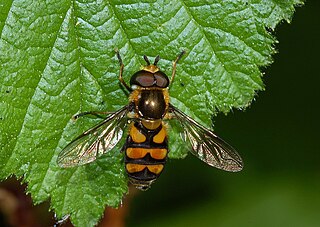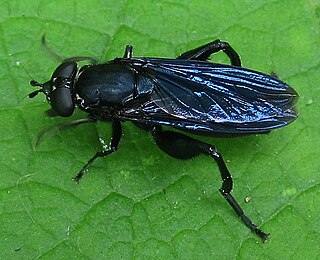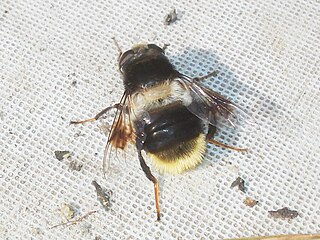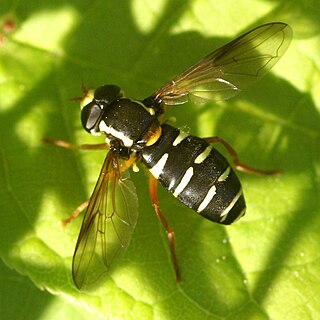
Eristalis is a large genus of hoverflies, family Syrphidae, in the order Diptera. Several species are known as drone flies because they bear a resemblance to honeybee drones.

Mallota is a widely distributed Holarctic genus of hoverfly, well known for their bee-like appearance.

Xylota is a Holarctic genus of hoverflies similar in structure to the related genera Chalcosyrphus and Brachypalpoides. As the larvae are saprophytic they're usually found in rotting wood. The adult flies are generally associated with woodland and woodland edges and can often be seen running over the upper sides of leaves. Unlike other syrphids the adults of many species rarely visit flowers preferring instead to gather pollen from leaf surfaces. There are over 100 described species of which 12 can be found in Europe. Seven species have been recorded in Britain. Identification of species has been difficult and identifiction by photographs is risky.

Philhelius pedissequus is a species of hoverfly. Prior to 2018, it was known under the genus name Xanthogramma, a junior synonym.

Temnostoma is a genus of hoverflies. The larvae of some species feed on the wood of deciduous trees.

The genus Chrysotoxum consists of large, wasp-mimicking species. The adults are distinguished by very long antennae, oval abdomen with yellow stripes, and yellow patterns on the thoracic pleurae . The species of Chrysotoxum are chiefly Holarctic in distribution. . The species in this genus, are mostly very uniform in structure and colour and are separated with difficulty. Larvae are specialized in preying upon root aphids associated with ant nests.

Platycheirus is a large genus of hoverflies. They are also called sedgesitters.

Didea, the lucent flies is a holarctic genus of black and yellow large sized flies 10–15 mm (0.39–0.59 in). belonging to the hoverfly family of Diptera. The larvae feed on aboreal aphids.

Melangyna is a genus of hoverflies.

Meliscaeva is a genus of hoverflies.

Melanostoma is a large genus of hoverflies. Little is known of their biology, but they are suspected to be general predators of small insects in leaf litter.

Blera is primarily a North American genus, though there are 3 species from Europe. The genus is characterized by the following characters:

Chalcosyrphus is a genus of hoverflies in the subfamily Eristalinae. Many species exhibit some degree of mimicry of various sawflies and other hymenopterans and are often brightly coloured or metallic in hue. The adults are similar in structure and behavior to the related genus Xylota but differ in larval morphology. They can be found throughout Europe, Asia, and North America and seem to prefer damper, boggy habitats. The larvae are saproxylic feeders in rotten wood in these habitats.

Chrysogaster is a genus of small hoverflies in the subfamily Eristalinae. They are dark or black with shiny colourful reflections and can often be seen visiting flowers in damp marshy areas where the aquatic larvae live. Species in the related genera Melanogaster, Orthonevra, Lejogaster and Riponnensia were formerly treated as members of Chrysogaster.

Sphegina is a genus of small, slender hoverflies. They are widespread throughout Eurasia and North America. In flight they seem to have long hind legs which they often carry hanging down, making them resemble sphecid or ichneumonid wasps. Adult Sphegina are usually found in damp and shady habitats close to water in forested areas, and several species can often be found together. They often feed on white and yellow flowers of Apiaceae, Ranunculaceae, Asteraceae, and Rosaceae like Crataegus, Sorbus, and Sorbaria. Larvae nest in the sap of living and dead trees or in decaying cambium under tree bark lying in water or other damp conditions. The larvae of some species have been discovered in the tunnels of other xylophagous insects.

Episyrphus is a genus of hoverflies in the subfamily Syrphinae. Larvae are predatory, often on aphids.

Eriozona is a genus of hoverflies in the subfamily Syrphinae.

Riponnensia is a genus of hoverflies.

Pipiza is a genus Hoverflies, from the family Syrphidae, in the order Diptera. Most are dark hoverflies.

Philhelius citrofasciatus is a species of hoverfly found in grasslands from Ireland to western Siberia. The larvae live in Lasius ant colonies where they feed on the aphids tended by the ants. Prior to 2018, it was known under the genus name Xanthogramma, a junior synonym.




















